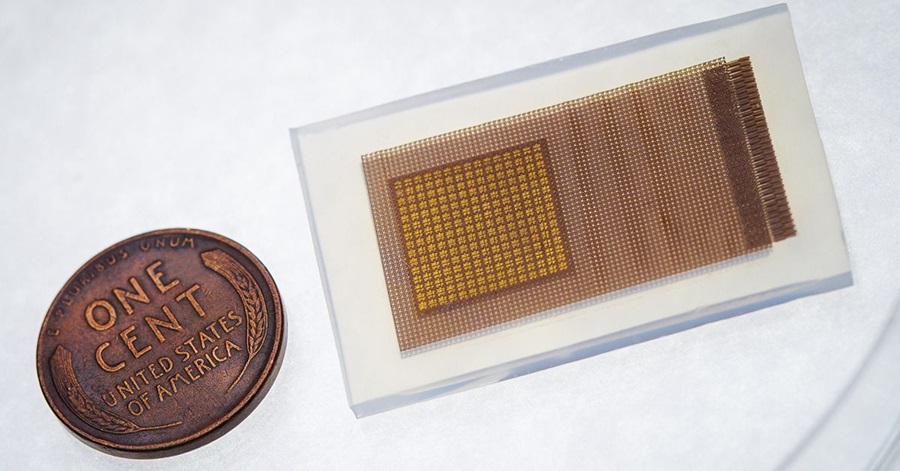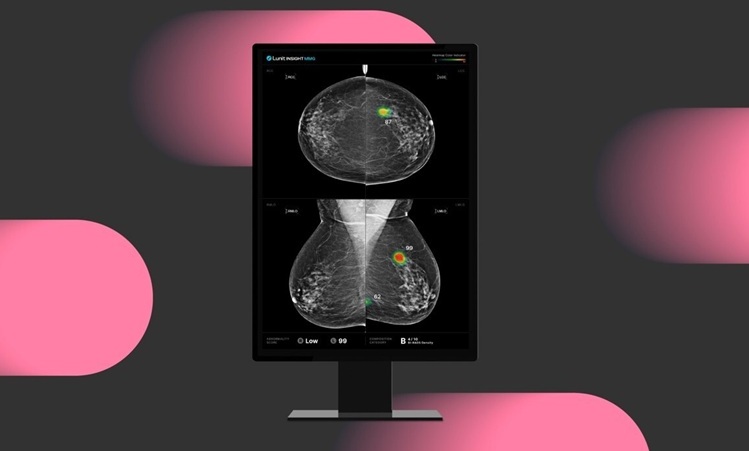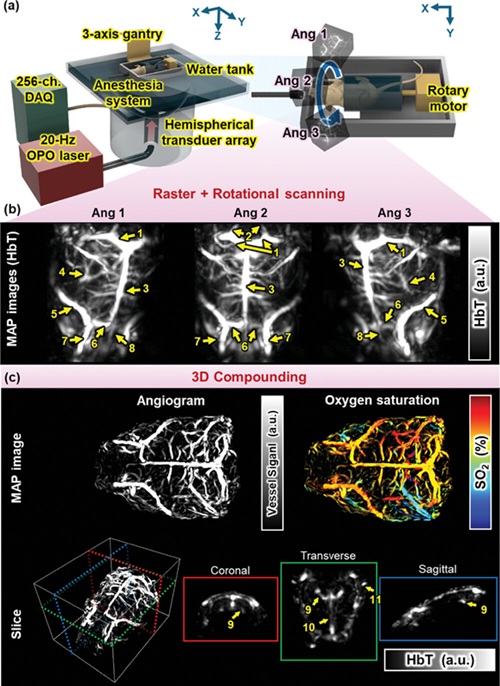Wearable Ultrasound Patch Continuously Monitors Cerebral Blood Flow 
|
By MedImaging International staff writers Posted on 24 May 2024 |

The standard clinical method for monitoring cerebral blood flow, transcranial Doppler ultrasound, depends on a skilled technician holding an ultrasound probe against the patient’s head. This method, however, has limitations. It is operator-dependent, which means the accuracy of the readings can vary with the operator's skill. Moreover, it is not suitable for continuous monitoring, as cerebral blood flow is usually checked only at specific times during the day, which may not capture fluctuations occurring at other times. Now, a wearable ultrasound patch overcomes these hurdles by offering a hands-free, consistent, and comfortable solution for monitoring cerebral blood flow that patients can wear continuously throughout their hospital stay.
Developed by engineers at the University of California San Diego (La Jolla, CA, USA), this wearable ultrasound patch allows for the continuous, non-invasive monitoring of cerebral blood flow. The patch, which is soft, stretchy, and worn on the temple, provides three-dimensional blood flow data, a first for wearable technology. This innovation is particularly beneficial for patients undergoing or recovering from brain surgery, representing a significant advancement over traditional transcranial Doppler ultrasound. The patch is about the size of a postage stamp and is made from a silicone elastomer containing several layers of stretchy electronics. It includes an array of small piezoelectric transducers that emit and receive ultrasound waves to measure blood flow.
Another essential feature of the patch is a copper mesh layer made of spring-shaped wires that enhance signal quality by reducing interference from the body and external environment. Additional layers include stretchable electrodes that support the patch’s functionality. For operation, the patch connects via cables to a power source and a computer. The system utilizes ultrafast ultrasound imaging to perform 3D monitoring. Unlike conventional ultrasound, which captures around 30 images per second, ultrafast imaging captures thousands, crucial for collecting detailed data from the piezoelectric transducers, which could otherwise be diminished by the strong reflection from the skull. Data are then processed using specialized algorithms to reconstruct three-dimensional details such as the size, angle, and position of the major brain arteries.
Researchers tested the ultrasound patch on 36 healthy volunteers to assess its ability to measure blood flow velocities—peak systolic, mean flow, and end-diastolic velocities—in the brain’s major arteries. The study participants undertook activities that affected blood flow, such as hand-gripping, breath-holding, and reading. The measurements of the ultrasound patch were almost similar to those obtained using a conventional ultrasound probe. The researchers will now collaborate with clinicians at UC San Diego School of Medicine to test the ultrasound patch on patients suffering from neurological conditions that affect cerebral blood flow.
“The continuous monitoring capability of the patch addresses a critical gap in current clinical practices,” said study co-first author Sai Zhou.
“The cerebral vasculature is a complex structure with multiple branching vessels. You need a device capable of capturing this three-dimensional information to get the whole picture and obtain more accurate measurements,” added Xinyi Yang, another co-first author of this study.
Related Links:
UC San Diego
Latest Ultrasound News
- Tiny Magnetic Robot Takes 3D Scans from Deep Within Body
- High Resolution Ultrasound Speeds Up Prostate Cancer Diagnosis
- World's First Wireless, Handheld, Whole-Body Ultrasound with Single PZT Transducer Makes Imaging More Accessible
- Artificial Intelligence Detects Undiagnosed Liver Disease from Echocardiograms
- Ultrasound Imaging Non-Invasively Tracks Tumor Response to Radiation and Immunotherapy
- AI Improves Detection of Congenital Heart Defects on Routine Prenatal Ultrasounds
- AI Diagnoses Lung Diseases from Ultrasound Videos with 96.57% Accuracy
- New Contrast Agent for Ultrasound Imaging Ensures Affordable and Safer Medical Diagnostics
- Ultrasound-Directed Microbubbles Boost Immune Response Against Tumors
- POC Ultrasound Enhances Early Pregnancy Care and Cuts Emergency Visits
- AI-Based Models Outperform Human Experts at Identifying Ovarian Cancer in Ultrasound Images
- Automated Breast Ultrasound Provides Alternative to Mammography in Low-Resource Settings
- Transparent Ultrasound Transducer for Photoacoustic and Ultrasound Endoscopy to Improve Diagnostic Accuracy
- Wearable Ultrasound Patch Enables Continuous Blood Pressure Monitoring
- AI Image-Recognition Program Reads Echocardiograms Faster, Cuts Results Wait Time
- Ultrasound Device Non-Invasively Improves Blood Circulation in Lower Limbs
Channels
Radiography
view channel
Higher Chest X-Ray Usage Catches Lung Cancer Earlier and Improves Survival
Lung cancer continues to be the leading cause of cancer-related deaths worldwide. While advanced technologies like CT scanners play a crucial role in detecting lung cancer, more accessible and affordable... Read more
AI-Powered Mammograms Predict Cardiovascular Risk
The U.S. Centers for Disease Control and Prevention recommends that women in middle age and older undergo a mammogram, which is an X-ray of the breast, every one or two years to screen for breast cancer.... Read moreMRI
view channel
Ultra-Powerful MRI Scans Enable Life-Changing Surgery in Treatment-Resistant Epileptic Patients
Approximately 360,000 individuals in the UK suffer from focal epilepsy, a condition in which seizures spread from one part of the brain. Around a third of these patients experience persistent seizures... Read more
AI-Powered MRI Technology Improves Parkinson’s Diagnoses
Current research shows that the accuracy of diagnosing Parkinson’s disease typically ranges from 55% to 78% within the first five years of assessment. This is partly due to the similarities shared by Parkinson’s... Read more
Biparametric MRI Combined with AI Enhances Detection of Clinically Significant Prostate Cancer
Artificial intelligence (AI) technologies are transforming the way medical images are analyzed, offering unprecedented capabilities in quantitatively extracting features that go beyond traditional visual... Read more
First-Of-Its-Kind AI-Driven Brain Imaging Platform to Better Guide Stroke Treatment Options
Each year, approximately 800,000 people in the U.S. experience strokes, with marginalized and minoritized groups being disproportionately affected. Strokes vary in terms of size and location within the... Read moreNuclear Medicine
view channel
Novel PET Imaging Approach Offers Never-Before-Seen View of Neuroinflammation
COX-2, an enzyme that plays a key role in brain inflammation, can be significantly upregulated by inflammatory stimuli and neuroexcitation. Researchers suggest that COX-2 density in the brain could serve... Read more
Novel Radiotracer Identifies Biomarker for Triple-Negative Breast Cancer
Triple-negative breast cancer (TNBC), which represents 15-20% of all breast cancer cases, is one of the most aggressive subtypes, with a five-year survival rate of about 40%. Due to its significant heterogeneity... Read moreGeneral/Advanced Imaging
view channel
AI Model Significantly Enhances Low-Dose CT Capabilities
Lung cancer remains one of the most challenging diseases, making early diagnosis vital for effective treatment. Fortunately, advancements in artificial intelligence (AI) are revolutionizing lung cancer... Read more
Ultra-Low Dose CT Aids Pneumonia Diagnosis in Immunocompromised Patients
Lung infections can be life-threatening for patients with weakened immune systems, making timely diagnosis crucial. While CT scans are considered the gold standard for detecting pneumonia, repeated scans... Read moreImaging IT
view channel
New Google Cloud Medical Imaging Suite Makes Imaging Healthcare Data More Accessible
Medical imaging is a critical tool used to diagnose patients, and there are billions of medical images scanned globally each year. Imaging data accounts for about 90% of all healthcare data1 and, until... Read more
Global AI in Medical Diagnostics Market to Be Driven by Demand for Image Recognition in Radiology
The global artificial intelligence (AI) in medical diagnostics market is expanding with early disease detection being one of its key applications and image recognition becoming a compelling consumer proposition... Read moreIndustry News
view channel
GE HealthCare and NVIDIA Collaboration to Reimagine Diagnostic Imaging
GE HealthCare (Chicago, IL, USA) has entered into a collaboration with NVIDIA (Santa Clara, CA, USA), expanding the existing relationship between the two companies to focus on pioneering innovation in... Read more
Patient-Specific 3D-Printed Phantoms Transform CT Imaging
New research has highlighted how anatomically precise, patient-specific 3D-printed phantoms are proving to be scalable, cost-effective, and efficient tools in the development of new CT scan algorithms... Read more
Siemens and Sectra Collaborate on Enhancing Radiology Workflows
Siemens Healthineers (Forchheim, Germany) and Sectra (Linköping, Sweden) have entered into a collaboration aimed at enhancing radiologists' diagnostic capabilities and, in turn, improving patient care... Read more








 Guided Devices.jpg)









